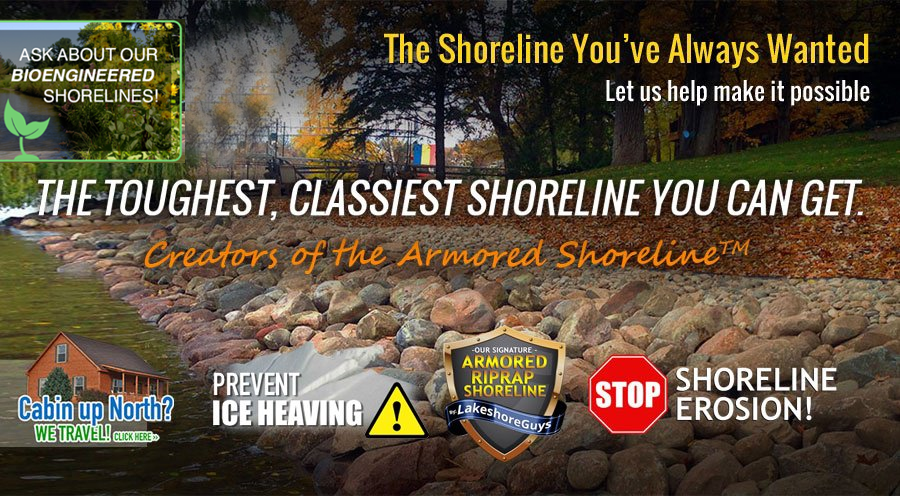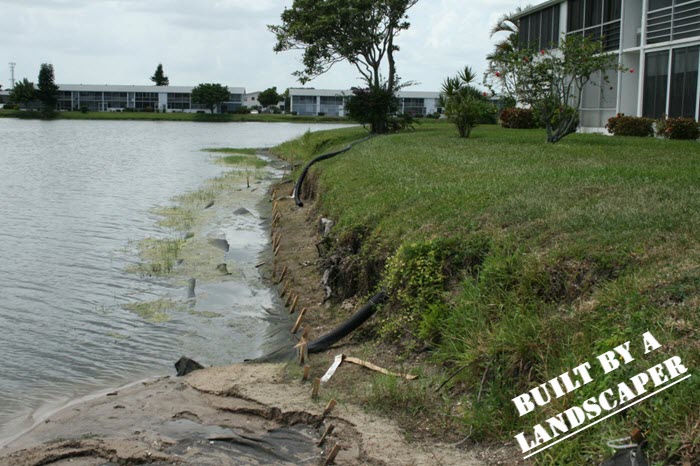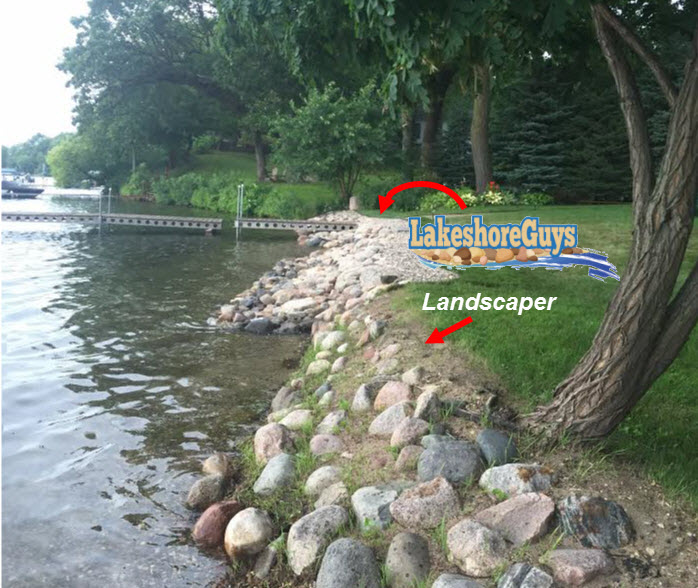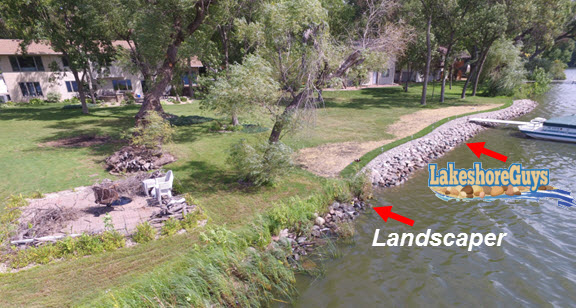Why You Should Not Hire a Landscaper – or Other Non-Specialist – For Your Shoreline Project (Or Boat Ramp)
My name is Joe Palumbo (“Welcome, Joe!”), and I have a problem:
I’m a landscaper. Proud of it, too: I’ve been landscaping for well over half my life, and I’ve helped many Minnesota homeowners perfect their patch of the Great Outdoors.
The trouble is I’m also a lakeshore craftsman, so it hurts to utter a truth I’ve realized after 20+ years in the field:
Most landscapers have no idea how to build or restore a durable, safe, and attractive lakeshore. The same is true of other non-specialist contractors.
They’re called landscapers for a reason. They specialize in land, not bodies of water. All the busted-up, ugly, and eroded shorelines (and boat ramps) we’ve been called to repair in the last 20+ years were built by landscapers.
I doubt most landscapers are trying to bite off more than they can chew. It’s just that homeowners assume that because a landscaper has heavy equipment and work with rock and dirt, they’re experts at shoreline work.
You wouldn’t ask your veterinarian to explain your child’s rash. Granted, it’s probably better than asking your accountant for medical advice. But the point is you’re best off asking someone who specializes.
By the way, believe it or not, I’m not just picking on landscapers. Everything below applies to other contractors, too – anyone who doesn’t specialize in shorelines. Some of the dilapidated shorelines we see are made by general contractors, though most are by landscapers. So I’m using “landscapers” as somewhat of a catch-all bucket.
There are a few specific mistakes that almost all landscapers – and other non-specialists – make when working on a shoreline:
Mistake 1: They’ll get the slope wrong. A landscaper may or not even create the proper gradient for your shoreline before covering it with fabric. It needs a 3:1 slope, or as close to 3:1 as possible. A proper slope is one of the two most important steps in constructing a shoreline that will resist erosion and collapse. More than 50% of the work involved with shoreline restoration is prepping the shoreline prior to any fabric and/or riprap installation. This is a crucial step that most landscapers skip or mishandle. Even most “lakeshore companies” skip this step. (Do they skip it to increase profits? Do they simply not know any better? I don’t know the answer to that).
Mistake 2: They’ll use landscaping fabric. Assuming your landscaper re-grades your shoreline to the correct slope (which rarely happens), what type of fabric will he or she use? They’ll likely use a product known as “landscaping fabric” (i.e., woven or Typar fabric). This is what landscapers use on a daily basis for everything from retaining wall backer, to a weed barrier. Like duct tape, it’s versatile and useful for many applications, but not for every application. Using landscaping fabric will be the Achilles heel of your lakeshore.
You need shoreline fabric – AKA needle-punch or filter fabric. It also needs to be the thickest, top-of-the-line shoreline fabric. It’s not cheap, but it’s less expensive than having to build a new riprap shoreline after the landscaping-fabric one collapses.
Filter fabric is special because it has many qualities that a traditional landscaping woven fabric does not. Filter fabric is a puncture and abrasion resistant geotextile fabric made from a biologically inert, petrochemical-based polymer referred to as polypropylene. It’s synthetic, so it won’t decompose from being submerged in water and exposed to bacteria, mold, mildew, or fungi. It’s largely unaffected by oils, various solvents, acids, and alkalis. Because filter fabric allows a certain percentage of water through it (from both sides), it greatly reduces horizontal hydrostatic pressure – and this is important when shorelines are concerned. Lastly, filter fabric has great filtering, confinement, and soil reinforcement qualities.
Filter fabric is the only fabric that should be used for a shoreline. But many landscapers only see fabric as a weed barrier, and only have the weed-barrier type of fabric at hand.
Mistake 3: They’ll install the fabric wrong. Even if you use the right fabric (filter fabric), there’s a right way and a wrong way to install it. It’s crucial that you don’t have any seams in your fabric. Should a seam become necessary, it must be overlapped the correct way, and 6’’ staples must be installed throughout the entire area located several feet to both the left and right sides of the seam.
The filter fabric must always be installed so that several feet extend into the water and all the way down to where the lake bottom becomes flat. Also, the fabric must be extra-long near the topside of the shoreline. Upon completion of the shoreline, there should always be excess fabric along the top edge.
If you plan to have a thin decorative rock border along your new lakeshore, then it’s crucial that you have enough extra filter fabric to go under your decorative rock to serve as a weed barrier. (I assume you want decorative rocks, not decorative weeds.) One piece of filter fabric should encompass the entire area of riprap and decorative rock. Doing so will provide your new shoreline with the best protection during periods of high water-levels or heavy rains.
Mistake 4: They’ll use crushed stone. Riprap, by definition, is considered to be any natural rock measuring 6-30 inches in diameter, used along a shoreline to minimize erosion. What this definition fails to tell inform you of, it that the type of stone used, and the correct mixture of sizes is also very important.
Landscapers love to use whatever riprap is ready available, inexpensive, and they almost always tend to focus too much on the color of riprap (e.g. what will “look” the best). If you want to use the absolute best riprap for your shoreline, the answer is almost always a nice clean mixture of 6-18 -inch smooth-sided fieldstone.
Landscapers seem to love using a large crushed stone vs. a smooth sided stone. We see this often and roll our eyes. Experience has taught us that any type of crushed stone will eventually punch or wear holes in the filter fabric over time – if it survives the installation phase at all. And you’ll have no way of knowing that there are holes, because…well, there are several tons of rocks on top of it. It make take months, or even years, but eventually your shoreline will crumble because the crushed rock turned the fabric into Swiss cheese.
Mistake 5: They’ll use dirty rocks. You’ll want to install the cleanest riprap rocks possible. Landscapers almost always buy their riprap from a local landscape supply center. That means you’re getting landscape-grade riprap. The riprap was excavated as-is and is full of dirt, quarry dust, and other detritus. Installing this subpar riprap without the use of a specially made rock bucket, which filters out the dirt and debris, will result in little piles of dirt and quarry dust all over your clean & freshly installed filter fabric. You know how sometimes grass and little plants can grow in the cracks of your driveway or pavement? Well, your riprap rocks may be covered with those very same weeds if the rocks are dirty.
As shoreline experts, we buy most of our riprap directly from the supplier. This means our riprap is sorted to a specific size (typically 6-18 inches in diameter), clean, and consistent in color. 75% of our riprap comes from the same supplier located approx. 200-miles north of the Twin Cities. Yes, we pay a tidy sum for it, but quality pays for itself, and in this case it means your lakeshore will stand the test of time.
How to find the one qualified landscaper in 100
I’m sure some landscapers are capable of building the kind of shoreline that will stand the test of time. You might be able to find this one landscaper in a hundred by seeing if they pass these tests:
- Do they talk about shoreline restoration in-depth on their site? If they know it, they’ll show it.
- Did they hand you a brochure that speaks about shorelines exclusively? If shoreline restoration is just another item on the menu, right between the BLT and the meatball sub, then the landscaper probably isn’t experienced enough to know all the mistakes to avoid.
- Does their business card and other branding mention shorelines specifically? If not, that’s another sign they’re dabblers.
- Give them a little pop quiz:
- “Do think regrading my shoreline is necessary, or will covering it with fabric and riprap be enough?” If the answer is “Nah, it’s fine,” or “We’ll give it a quick grade to smooth it out,” it’s time for a Dear John letter. The landscaper should stress how important the slope of your shoreline is, and if they’d better mention mention “3-to-1” (the ideal grade of a riprap shoreline).
- “What do you use for fabric under the riprap, if any?” If their answer isn’t “needle-punch filter-fabric,” then you’re talking with someone who doesn’t know that fabric is really what holds a shoreline together – and that the wrong kind of fabric makes or breaks it. The very best answer would be: “We use 8 ounce needle-punch filter-fabric, and we also staple it down to the ground.”
- “What would you use for stone on my shoreline?” If the answer isn’t “Smooth, round riprap stones no bigger than 30 inches in diameter,” then you should tell the landscaper to stick with mulch and mud. An even better answer would be: “We use smooth round riprap no large than 18-inches in diameter.
- “How do you get the riprap to my shoreline?” The answer should be, “Why, in a special rock bucket, of course!” To use a traditional dirt bucket for your shoreline is a great way to include hundreds of pounds of dirt into something that should be pure stone. Do you think the Pyramids would have stood for this long if they were filled with dirt?
- “Do you think I need a permit for this work?” If they say “Gee, I don’t know,” then you just dodged a bullet.
I would wager none of the landscapers you’ve contacted was able to meet all those criteria to your satisfaction.
If that’s the case, call us, Lakeshore Guys®. We’ll build you a riprap shoreline that lasts.






